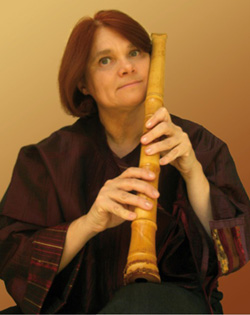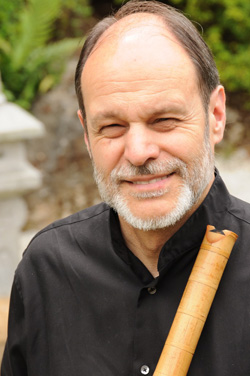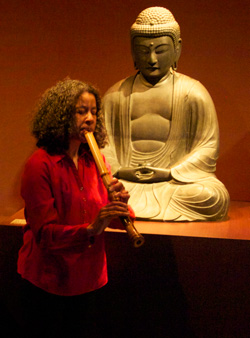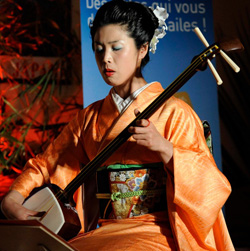TEACHERS
Taizan KAWAMURA
Born in 1947, Taizan Kawamura studied with the Dedicated Living National Treasure Hōzan Yamamoto. Taizan Kawamura is a graduate from the Faculty of Engineering of Dōshisha University, the Musicology Department of Seiha Music Institute, and NHK’s Japanese Traditional Music Training Course. He has for example been awarded with the Minister of Education Award (1983) as number one in the Tozan School of Shakuhachi All Japan Competition, the Agency of Cultural Affairs Art Festival Award (1988), the Tozan Award (1989), and the Grand Prize of the first Seoul Flute Festival (1996).
Apart from his solo performer career, Taizan Kawamura is also active as a member of the sankyoku (koto, shamisen, shakuhachi) group “Atarashii Kaze” [New Wind] and the orchestra “Mutsunowo” for traditional Japanese instruments. He has a wide repertoire from classical pieces to contemporary music, and he is also composing his own music. Sponsored by the Japan Foundation he has toured some twenty countries, mainly in Europe.
Taizan Kawamura is examiner of the Tozan School Chikurinken, and as a lecturer of Tozan School he tours all over Japan to give workshops and master-classes. He is a board member of the NPO Nihon Ongaku Kokusai Kōryū-kai [The Japanese Association for an International Exchange of Music], a board member of the Gendai Hōgaku Sakkyoku-sha Renmei [The Union of Composers of Contemporary Music for Japanese Instruments], musical director of the orchestra “Mutsunowo”, and a member of the Yamamoto Hōzan Shakuhachi Ensemble. He has published his own music through the Tozan-ryū Shuppan-bu [Tozan School Publication Bureau], and the Dai-Nihon Katei Ongaku-kai [The Japan Household Music Association].

Taizan KAWAMURA
Kizan KAWAMURA
Born in Tokyo, Kawamura graduated from Engineering Department of Tōyō University. He graduated from the 51st class of NHK’s Japanese Traditional Music Training Course. Kizan Kawamura studied shakuhachi with his father Taizan Kawamura, and received his master licenses jun-shihan and shihan with honours from the Tozan Gakkai School of shakuhachi. Sponsored by the Japan Foundation he has toured Russia and the US. Kizan Kawamura has passed the NHK audition, and has appeared on the NHK Radio program “Hōgaku Hitotoki” [A Moment of Japanese Music]. In 2009 he received the Grand Prize at the 15th Kumamoto All-Japan Traditional Music Competition and the Minister of Education, Culture, Sports, Science and Technology Promotional Prize, and the same year he also appeared on the NHK TV-program “Geinō Hana-butai” [Grand Stage of Artistery]. Kizan Kawamura won the Gold Prize, the Minister of Education, Culture, Sports, Science and Technology Promotional Prize, the Sōke [head of school] Cup, and the Nikkei Newspaper Cup in both the 36th (2010) and 38th (2012) Tozan School All-Japan Honkyoku Competitions.
Presently, Kizan Kawamura is a Tozan School shihan, and an assistant lecturer. He is a member of the Tozan Gakkai School of Shakuhachi, the Taizan Association, the orchestra “Mutsunowo” for traditional Japanese instruments, the “Shakuhachi Trio Band”, the “Theatrical Troupe TNB”, the shakuhachi quartet “Hachiku”, and others. Kizan Kawamura is based in Tokyo, where he teaches and performs at schools and culture centers, children rhythmic classes and other venues to spread shakuhachi music to a broader public. Kizan Kawamura also teaches at his own shakuhachi studios in the Nerima Ward in Tokyo and the Ina City in Nagano Prefecture.

Kizan KAWAMURA
Sōzan KARIYA
Sōzan Chiaki Kariya was born in Hyogo near Osaka. He studied shakuhachi at the age of 13 with his father, counselor of the Shin-Tozan school, student of Itsuzan Hoshida Ist and founder of Shingensha branch of the Ikuta School of koto. He obtained his title of daishihan (grand master) and became a teacher at Kōbe shinbun (Cultural Center of Kōbe Journal).
He came to France to study classical music (Paris Conservatory and Pasdeloup orchestra in cello), and became the representative of Shin-Tozan Ryū in France. Sōzan Kariya has many musical activities in France, Belgium, Japan, Germany and England. He has had great success at the Womad festival in London for his shakuhachi solo recital. He has been seen on TF1, France 3, the Pop Club of José Arthur with Richard Boringhé and at Musicora show. He has given concerts at the Guimet Museum and the Jacquemart-André Museum in Paris, in Cabourg, Hilden and in Düsseldorf, Germany ; he recorded several CDs under Air Mail Music label.
www.shintozanryu-france.com

Sōzan KARIYA
Gunnar Jinmei LINDER
Gunnar Linder began to study the shakuhachi after having arrived in Japan in 1985. He studied with Yamaguchi Gorō (1933–99), and received his traditional master license, shihan, and the name Jinmei (儘盟) from Yamaguchi Gorō in the summer of 1998. The year before he had graduated from the traditional music conservatoire of Tokyo National University of the Arts (Tokyo Geidai) with an MA degree in shakuhachi as performing art, at the time the second non-Japanese to do so.
In 2005 Gunnar moved back to his native Sweden, working as Associate Professor in Japanese Studies at Stockholm University. His research is mainly focused on the performing arts of the Edo period. Gunnar teaches and performs widely in Europe.

Gunnar Jinmei LINDER
Wolfgang Fuyūgen HEßLER
Wolfgang Fuyūgen Heßler studied the Japanese bamboo-flute Shakuhachi in the tradition of the Kinko-School with Dr. Andreas Fuyū Gutzwiller at the Studio for extraeuropean Music of the Academie of Music Basel.
Several journeys to and study visits in Japan took him to Kawase Junsuke III, head of the Zenkoku Chikuyusha in Tokyo, who performed the Shihan-Menyô-Ceremony for him to confirm the reception of the tradition. In addition, Wolfgang Hessler studied with Nobuhisa Ikkei Hanada in the tradition of the temple Itchōken (Hakata/Kyūshū).
Wolfgang Hessler lives and teaches in Zurich, performing in concerts and recitals traditional Japanese music (honkyoku and gaikyoku) and contemporary music.

Wolfgang HEßLER
Véronique PIRON
Véronique Piron, a French flautist based in West of France (Brittany), is a shakuhachi master-performer in the style transmitted by Yokoyama Katsuya (KSK) who awarded her a shihan-licence in 2002 while recipient of a Lavoisier research grant from the French government for studying in Japan.
She participated in the creation of the ESS, and developed the teaching of the shakuhachi primarily in the style of the KSK in Paris and Brussels. As a licensed conservatoire teacher for traditional music she is also introducing Japanese music in the French conservatoire system and higher education.
From tradition to creation, Véronique Piron is widely produced in a solo programm, in a duo with the koto/shamisen player Fumie Hihara, in an intercultural new music programme with pianist Lydia Domancich (Cd Sillage (Wake) 2015), and meets with composers for new music.
www.veroniquepiron.com

Véronique PIRON
Daniel SEISOKU LIFERMANN
Daniel Seisoku Lifermann started learning Shakuhachi in 1983 while visiting Japan and subsequently studied with Franck Noël, a student of Yokyoyama Katsuya, in France. From 1989 to 1997 he studied under Iwamoto Yoshikazu and also with Gunnar Jinmei Linder. Since 1999, he has been a follower of Fukuda Teruhisa, a student of Miyata Kohachiro, and is the founder of the Hijiri School / Sainte-École), and with whom he regularly organises intensive courses. In 2008, Daniel was awarded the title of Dai Shihan and the name of “Seisoku” (breath of wisdom).
Since 1988, he has been teaching Shakuhachi and, in 1994, founded the French association “La Voie du Bambou”, to spread the wings and practice of Shakuhachi. He works tirelessly to share what he has received from his various masters and performs regularly in concert.
www.shakuhachi.fr

Daniel SEISOKU LIFERMANN
Dr Jim FRANKLIN
Dr Jim Franklin is a master performer of the shakuhachi. Now resident in Germany, he initially studied composition and musicology in Australia, Germany and Holland. During his studies he encountered the shakuhachi, and was fascinated by it. After learning the instrument in Australia with Dr Riley Lee and in Japan with Furuya Teruo and Yokoyama Katsuya, he received the title Shihan (“master”) in 1996 from Yokoyama-sensei, and was thus officially licensed to teach and perform shakuhachi.
As a composer, Franklin is active in the areas of contemporary and electroacoustic music, composing for shakuhachi solo and in combination with other instruments including live electronics. In the area of solo shakuhachi, Franklin has specialized in the honkyoku of the Kokusai Shakuhachi Kenshukan and in modern music.
From 2006 to 2009 he was founding Chairperson of the European Shakuhachi Society.

Dr Jim FRANKLIN
Hélène Seiyu CODJO
Hélène Seiyu Codjo is a French flutist and started to learn shakuhachi with Daniel Seisoku Lifermann in Paris in the French association « La Voie du Bambou ». Since 2006, she regularly attends masterclasses of Fukuda Tehurisa, founder of the ensemble and school Hijiri-Kai. In January 2013, she received the Jun Shihan degree with the name Seiyu from him.
She also followed masterclasses with Yodo Kurahashi II, Gunnar Jinmei Linder, Christopher Yohmei Blasdel, Jim Franklin, Shimura Zempo and Koichi Yoshida.
She lives in the Netherlands, where she gives lessons, workshops and concerts (www.fluitshakuhachi.nl).
Furthermore, she writes shows where she plays other world flutes (quena, dizi, African flutes,…) in addition to the shakuhachi and the western flutes. She also works with storytellers and has recorded a dozen CDs for children with her different flutes.

Hélène Seiyu CODJO
Fiore de MATTIA
Fiore de Mattia is a member of the French society “La Voie Du Bambou”, whose purpose is to teach and disseminate Shakuhachi. In 2003, he began learning Shakuhachi with Master Daniel LIFERMANN and as of 2006, he continued studying under the guidance of Master Teruhisa FUKUDA, from the “Hijiri-Kai” School (“Sainte École”).
Since 2012, he hold concerts in Italy and France : “The Sound of Zen Buddhism”.
In 2013, he achieved the title of “Shihan”, granted by Master Tehurisha FUKUDA

Fiore de MATTIA
Suizan J.-F. LAGROST (principal organiser)
Suizan J.-F. Lagrost is professor of art education at the conservatories of Le Kremlin-Bicêtre and Asnières. As a versatile musician, he excels in both the Western and Japanese musics. After a traditional curriculum of concert flute in Mulhouse and Paris, then a DEA of Music of the 20th century at the University of Paris-Sorbonne, he began the shakuhachi in 2000 (Tozan style) and obtained in 2014 the title of Dai-Shihan (grand master).
The diversity of his expertise conducts him to appear in a variety of backgrounds : the Ensemble de flûtes de Paris, flute & piano recitals in Taiwan, as a soloist with the Musique de la Garde républicaine, as well as Summer Schools and Festivals of shakuhachi in Europe (Barcelona, Prague, etc.) He published in 2013 a Japanese chamber music CD entitled “Kyoku” with the koto player Mieko Miyazaki.
As a Senior Advisor of the European Shakuhachi Society, he has founded and administered since 2011 the world main forum of shakuhachi (www.shakuhachiforum.eu).(www.shakuhachiforum.eu).
http://www.flute-shakuhachi.com

Suizan J.-F. LAGROST
Mieko MIYAZAKI
Born in Tokyo. After being accepted to the “Tokyo National University of Fine Arts and Music”, her training finished with an invitation to perform as a soloist in the presence of the imperial couple in Japan. She graduated in 1992, and the following year she was awarded the highest distinctions by the national radio NHK-FM.In 2003, her work “The Current” (CD Columbia Records-Japan for the duo “East Current”) for Koto and Shakuhachi Flute, was directed by Dozan FUJIWARA and is considered one of the thirty most beautiful compositions of all time by the Hogaku Journal specialists, “the Kotoby”.
Moving to France in 2005, her European career began quickly despite both herself and koto being relatively unknown to the European market. Mieko Miyazaki became immediately recognized and established worldwide as one of the leading figures in Japanese koto and pushing the limits and capacities of her music and instrument in many different music genres. She is very busy with many project touring schedule taking her to all corners of the globe from Europe, the USA, China, South America, India, Korea, Canada, Taiwan, Hong Kong, Turkey, Egypt, Madagascar and Japan.
www.miekomiyazaki.com

Mieko MIYAZAKI
Fumie HIHARA
Fumie Hihara plays the koto and the shamisen since a very young age. Coming from both traditional and university fields, she is a koto master of the Yamada school since the age of 17 years, and high graded from the National University of Fine arts and Music of Tôkyô in 1998.
Sharing her life between France and Japan, between artistic activities, compositions and teaching, she is as much innovative and flexible as respectful of the tradition. She proposes to explore the potential of those traditional instruments to deliver us the most relevant expression of a musical experience which binds the past and the present.
Many events and concerts as much in Europe as in Japan, creations of composers’ new music, experimental music, and recording of 7 CDs.
www.fumiehihara.com

Fumie HIHARA
Etsuko CHIDA
Etsuko Chida was born in Sapporo, the main cite of Hokkaido island.
She studied, from the age of 5 years old, the art of singing and koto in the style of the Yamada school, following the traditional teaching of three of the greatest koto virtuosos, Kaga Toyomasa, Yokota Toyochika and Sanagi Okatoyo. During her study she has been awarded a natori, the professional name of Toyochi Eka.
She has recorded a solo album of courteous songs, for the label Buda Records which was critically acclaimed. She has performed widely in concerts, first in Japan, then in France, as well as in Europe or in Mahgreb.
www.etsukochida.com

Etsuko CHIDA
STYLES & SCHOOLS
Tozan, Kinko (Chikumeisha,Chikuyūsha), KSK, Hijiri, Contemporary, Improvisation, Ikuta, Yamada
LEVELS OF INSTRUCTIONS
Starting up, beginners, intermediate and advanced. Instruction will be available for participants who have never played shakuhachi,
and who are commencing at the Summer School. Plastic beginners’ instruments will be available for loan or purchase.
PLEASE NOTE THAT INSTRUMENTS OF LENGTH 1.8 SHAKU WILL BE USED FOR ALL TEACHING.
If you do not possess a shakuhachi of this length, you will need to obtain one before the Summer School,
or borrow a plastic beginner’s instrument at the Summer School.
